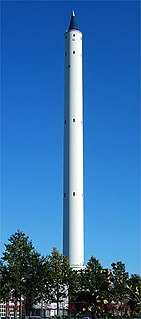Related Research Articles
The Helmholtz Association of German Research Centres is the largest scientific organisation in Germany. It is a union of 18 scientific-technical and biological-medical research centers. The official mission of the Association is "solving the grand challenges of science, society and industry". Scientists at Helmholtz therefore focus research on complex systems which affect human life and the environment. The namesake of the association is the German physiologist and physicist Hermann von Helmholtz.

The Dresden University of Technology is a public research university, the largest institute of higher education in the city of Dresden, the largest university in Saxony and one of the 10 largest universities in Germany with 32,389 students as of 2018.

The German Research Foundation is a German research funding organization, which functions as a self-governing institution for the promotion of science and research in the Federal Republic of Germany. In 2019, the DFG had a funding budget of €3.3 billion.

The University of Bremen is a public university in Bremen, Germany, with approximately 23,500 people from 115 countries. It is one of 11 institutions which were successful in the category "Institutional Strategies" of the Excellence Initiative launched by the Federal Government and the Federal States in 2012. The university was also successful in the categories "Graduate Schools" and "Clusters of Excellence" of the initiative.

Friedrich–Alexander University Erlangen–Nürnberg is a public research university in the cities of Erlangen and Nuremberg in Bavaria, Germany. The name Friedrich–Alexander comes from the university's first founder Friedrich, Margrave of Brandenburg-Bayreuth, and its benefactor Christian Frederick Charles Alexander, Margrave of Brandenburg-Ansbach.
The Gottfried Wilhelm Leibniz Prize, in short Leibniz Prize, is awarded by the German Research Foundation to "exceptional scientists and academics for their outstanding achievements in the field of research". Since 1986, up to ten prizes are awarded annually to individuals or research groups working at a research institution in Germany or at a German research institution abroad. It is considered the most important research award in Germany.

The Karlsruhe Institute of Technology is a public research university and one of the largest research and educational institutions in Germany. KIT was created in 2009 when the University of Karlsruhe, founded in 1825 as a public research university and also known as the "Fridericiana", merged with the Karlsruhe Research Center, which had originally been established in 1956 as a national nuclear research center.

Science and technology in Germany have been very significant and research and development efforts form an integral part of the country's economy. Germany has been the home of some of the most prominent researchers in various scientific disciplines, notably physics, mathematics, chemistry and engineering. Before World War II, Germany had generated more Nobel laureates in scientific fields than any other nation, and was the preeminent country in the natural sciences.

TU9 German Universities of Technology e. V. is the alliance of nine leading Technical Universities in Germany. The current president of TU9 is Wolfram Ressel, rector of the University of Stuttgart.

Caroline Y. Robertson-von Trotha is a Scottish sociologist and cultural scientist, working in Germany.
Magdalena Götz is a German neuroscientist. She is noted for her study of glial cells and holds a chair at Ludwig Maximilian University of Munich's Department of Physiology.

The Max-Reger-Institute (MRI) is a musicological research institute and archive in Karlsruhe, Germany, dedicated to the work of the composer Max Reger, a representative of German music around the turn of the 20th century. An associated foundation, the Elsa-Reger-Stiftung, is named after his wife, Elsa Reger, who founded the foundation and the institute. It has a substantial archive of manuscripts and documents related to Reger.
Gerald H. Haug is a German geologic climatologist, prize winner of the Gottfried Wilhelm Leibniz Prize and since 2007 he has a professorship at the ETH Zürich in Switzerland. In 2015 he became director of the Climate Geochemistry Department and Scientific Member at the Max Planck Institute for Chemistry in Mainz and since March 2020, he became the new President of the National Academy of Sciences Leopoldina.

Open access to scholarly communication in Germany has evolved rapidly since the early 2000s. Publishers Beilstein-Institut, Copernicus Publications, De Gruyter, Knowledge Unlatched, Leibniz Institute for Psychology Information, ScienceOpen, Springer Nature, and Universitätsverlag Göttingen belong to the international Open Access Scholarly Publishers Association.

Peter Nick is a German Molecular Biologist, and head of Molecular Cell Biology at the Karlsruhe Institute of Technology (KIT), and long-standing Academic Dean for Chemistry und Biology, He was co-initiator of the Forum for Critical Transdisciplinary Studies (FKI) and recipient of the State Teaching Award of Baden-Württemberg in 2015.

Marlis Hochbruck is a German applied mathematician and numerical analyst known for her research on matrix exponentials, exponential integrators, and their applications to the numerical solution of differential equations. She is a professor in the Institute for Applied and Numerical Mathematics at the Karlsruhe Institute of Technology.
The IT cluster Rhine-Main-Neckar, also known as Silicon Valley of Germany, is one of the most important locations of the IT and high-tech industry worldwide. It is concentrated in the Rhine-Main and Rhine-Neckar metropolitan regions. The IT cluster Rhine-Main-Neckar is the largest IT cluster in Europe. 50 percent of the worldwide revenue of the hundred largest European software companies are generated by companies in this region. The Rhine-Main-Neckar region also has one of the most important biopharmaceutical, fintech, finance and consulting clusters in Europe.
Christian Lammert is a German politologist.

Ali Sunyaev is a professor for computer science and director of the Institute of Applied Informatics and Formal Description Methods at the Karlsruhe Institute of Technology (KIT).
Werner Breig is a German musicologist and music publisher.
References
- ↑ Birth year from German National Library catalog entry, retrieved 2019-07-20.
- ↑ Gauss Centre for Supercomputing (22 August 2017), Research team uses computation and experiment to understand how novel material properties form, phys.org
- 1 2 Professor Dr. Britta Nestler, Deutsche Forschungsgemeinschaft, 2017, retrieved 2019-07-20